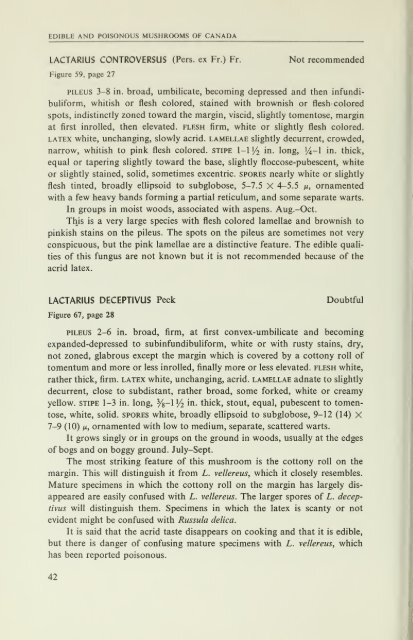Create successful ePaper yourself
Turn your PDF publications into a flip-book with our unique Google optimized e-Paper software.
EDIBLE AND POISONOUS MUSHROOMS OF CANADA<br />
LACTARIUS CONTROVERSUS (Pers. ex Fr.) Fr. Not recommended<br />
Figure 59, page 27<br />
PILEUS 3-8 in. broad, umbilicate, becoming depressed and then infundi-<br />
buliform, whitish or flesh colored, stained with brownish or flesh- colored<br />
spots, indistinctly zoned toward the margin, viscid, slightly tomentose, margin<br />
at first inrolled, then elevated, flesh firm, white or slightly flesh colored.<br />
LATEX white, unchanging, slowly acrid, lamellae shghtly decurrent, crowded,<br />
narrow, whitish to pink flesh colored, stipe l-U/^ in. long, J4-1 in. thick,<br />
equal or tapering slightly toward the base, shghtly floccose-pubescent, white<br />
or slightly stained, soHd, sometimes excentric. spores nearly white or shghtly<br />
flesh tinted, broadly ellipsoid to subglobose, 5-7.5 X 4-5.5 m, ornamented<br />
with a few heavy bands forming a partial reticulum, and some separate warts.<br />
In groups in moist woods, associated with aspens. Aug.-Oct.<br />
This is a very large species with flesh colored lamellae and brownish to<br />
pinkish stains on the pileus. The spots on the pileus are sometimes not very<br />
conspicuous, but the pink lamellae are a distinctive feature. The edible quali-<br />
ties of this fungus are not known but it is not recommended because of the<br />
acrid latex.<br />
LACTARIUS DECEPTIVUS Peck Doubtful<br />
Figure 67, page 28<br />
PILEUS 2-6 in. broad, firm, at first convex-umbilicate and becoming<br />
expanded-depressed to subinfundibuliform, white or with rusty stains, dry,<br />
not zoned, glabrous except the margin which is covered by a cottony roll of<br />
tomentum and more or less inrolled, finally more or less elevated, flesh white,<br />
rather thick, firm, latex white, unchanging, acrid, lamellae adnate to shghtly<br />
decurrent, close to subdistant, rather broad, some forked, white or creamy<br />
yellow. STIPE 1-3 in. long, %-l Yz in. thick, stout, equal, pubescent to tomentose,<br />
white, sohd. spores white, broadly eUipsoid to subglobose, 9-12 (14) X<br />
7-9 (10) M, ornamented with low to medium, separate, scattered warts.<br />
It grows singly or in groups on the ground in woods, usually at the edges<br />
of bogs and on boggy ground. July-Sept.<br />
The most striking feature of this mushroom is the cottony roll on the<br />
margin. This will distinguish it from L. vellereus, which it closely resembles.<br />
Mature specimens in which the cottony roll on the margin has largely dis-<br />
appeared are easily confused with L. vellereus. The larger spores of L. decep-<br />
tivus will distinguish them. Specimens in which the latex is scanty or not<br />
evident might be confused with Russula delica.<br />
It is said that the acrid taste disappears on cooking and that it is edible,<br />
but there is danger of confusing mature specimens with L. vellereus, which<br />
has been reported poisonous.<br />
42

















